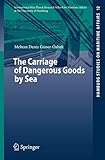The Carriage of Dangerous Goods by Sea / by Meltem Deniz Güner-Özbek.
Tipo de material: TextoSeries Hamburg Studies on Maritime Affairs ; 12Editor: Berlin, Heidelberg : Springer Berlin Heidelberg, 2008Descripción: recurso en líneaTipo de contenido:
TextoSeries Hamburg Studies on Maritime Affairs ; 12Editor: Berlin, Heidelberg : Springer Berlin Heidelberg, 2008Descripción: recurso en líneaTipo de contenido: - texto
- computadora
- recurso en línea
- 9783540758372
- K7000-7720.22
Springer eBooks
Dangerous goods regulations -- Meaning of dangerous goods -- Duties of the parties in relation to dangerous goods -- Rights and liabilities of the parties -- Limitation of liability and insurance -- Third-party liability for damage arising from the carriage of HNS -- Conclusion.
The carriage of goods by sea mainly focuses on loss of or damage to goods. There are voluminous discussions and texts on this issue. By contrast, the issue of loss or damage from goods has been paid little attention. Ever-increasing numbers of dangerous goods are carried by sea today. This increase draws attention to explosions or fire on ships, spillages, pollution, accidents and potential danger. Worldwide concern with the risk posed by the increased frequency in the carriage of dangerous goods has led to the adoption of international technical standards to promote maritime safety and the insertion of special provisions in the carriage contracts. Moreover, growing environmental awareness and concern with the economic cost implications of maritime casualties have given rise to the regulation of liability and compensation in respect of damage caused by hazardous and noxious substances.
Para consulta fuera de la UANL se requiere clave de acceso remoto.


